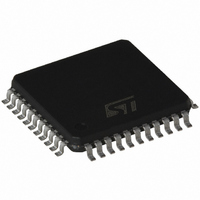L6710 STMicroelectronics, L6710 Datasheet - Page 22

L6710
Manufacturer Part Number
L6710
Description
IC CTRLR 6BIT 2PH PROGR 44-TQFP
Manufacturer
STMicroelectronics
Type
Step-Down (Buck)r
Datasheet
1.L6710.pdf
(34 pages)
Specifications of L6710
Internal Switch(s)
No
Synchronous Rectifier
Yes
Number Of Outputs
2
Voltage - Output
0.84 ~ 1.6 V
Current - Output
2A
Frequency - Switching
150kHz
Voltage - Input
12V
Operating Temperature
0°C ~ 125°C
Mounting Type
Surface Mount
Package / Case
44-TQFP, 44-VQFP
Power - Output
2.5W
Product
Half-Bridge Drivers
Supply Current
12.5 mA
Mounting Style
SMD/SMT
Lead Free Status / RoHS Status
Lead free / RoHS Compliant
Available stocks
Company
Part Number
Manufacturer
Quantity
Price
Company:
Part Number:
L671000
Manufacturer:
PHI
Quantity:
1 870
Part Number:
L671000
Manufacturer:
OKI
Quantity:
20 000
L6710
Considering now that in the application of interest it can be assumed that Ro>>R
R
The ACM control loop gain is designed to obtain a high DC gain to minimize static error and cross the 0dB
axes with a constant -20dB/dec slope with the desired crossover frequency ω
Z
designed and the zero is fixed by ESR and the Droop resistance. To obtain the desired shape an R
series network is considered for the Z
er with an integrator. This integrator minimizes the static error while placing the zero in correspondence
with the L-C resonance a simple -20dB/dec shape of the gain is assured (See Figure 15). In fact, consid-
ering the usual value for the output filter, the LC resonance results to be at frequency lower than the above
reported zero.
Compensation network can be simply designed placing ω
T as desired obtaining:
Figure 15. ACM Control Loop Gain Block Diagram (left) and Bode Diagram (right).
LAYOUT GUIDELINES
Since the device manages control functions and high-current drivers, layout is one of the most important
things to consider when designing such high current applications.
A good layout solution can generate a benefit in lowering power dissipation on the power paths, reducing
radiation and a proper connection between signal and power ground can optimize the performance of the
control loops.
Integrated power drivers reduce components count and interconnections between control functions and
drivers, reducing the board space.
Here below are listed the main points to focus on when starting a new layout and rules are suggested for
a correct implementation.
22/34
F
DROOP
(s), the transfer function has one zero and two poles. Both the poles are fixed once the output filter is
V
COMP
<<Ro, it results:
PWM
G
LOOP
Z
F
d•V
C
R
F
s ( )
IN
F
=
R
=
L/2
I
F
Cout
ESR
R
----------------------------------
FB
–
F B
4
-- -
5
⋅
⋅
V
------------------ -
∆ V
REF
∆ V
IN
V
OSC
IN
OSC
R
V
OUT
FB
F
⋅
(s) implementation. A zero at ω
⋅
Rout
Z
-------------- -
5
-- - ω
4
R
F
⋅
F B
s ( )
T
⋅
⋅
--------------------------------------------------------------------------------------------------------------------------------- -
s
------------------------------------------------------ -
2
2
⋅
⋅
(
Co
R
K
DROOP
K
=
⋅
L
-- -
2
4
5
1
L
+
⋅
+
∆V
s
dB
s Co
V
+
⋅
Z
IN
OSC
⋅
= ω
ESR
---------------
2 Ro
⋅
⋅
R
L
LC
1
⋅
FB
)
(
R
and imposing the cross-over frequency
dB
+
DROOP
Co ESR
ω
LC
F
=1/R
⋅
C
G
F
LOOP
+
ω
=
F
Z
ESR
C
+
------------------- -
F
Co
Co
T
R
is then introduced togeth-
)
. Neglecting the effect of
F
⋅
⋅
L
-- -
2
R
------ -
2
L
+
L
; ESR<<Ro and
1
ω
Z
T
F
(s)
ω
F
-C
F













